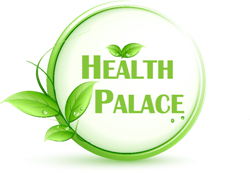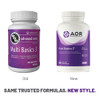Description
AOR Multi Basics 3 - 90 Veg Capsules:
A Complete Multivitamin.
Multi Basics 3 includes all recognized essential vitamins as part of a multivitamin/mineral complex for the maintenance of good health. Multi Basics 3 also helps normal growth and development.
- Includes all recognized essential nutrients
- Provides nutrients in properly balanced ratios
- Reflects biological needs and avoids harmful excesses
- Contains nutrients in amounts found in an optimal diet
While many multivitamins deliver nutrients in low quality forms, insufficient amounts or unbalanced ratios, Multi Basics 3 aims to correct all of these factors, creating a solid foundation for good health. Multi Basics 3 provides optimal doses and balanced ratios of all the recognized essential vitamins and minerals in high quality forms supported by research, all in just 3 capsules a day.
A balanced and well-designed multivitamin is fundamental to any supplement regimen. Multivitamin and mineral formulations are an excellent way to meet your daily nutrition requirements of all essential nutrients, providing a foundation on which to build your path to good health. While some nutrients like vitamins A and E are better absorbed and more effective in their natural forms, others are better absorbed in synthetic supplement form, such as folate and other B-vitamins. Some nutrients like zinc and copper must be delivered in balanced ratios so as not to disrupt certain bodily functions. Too much of some nutrients like vitamin B2 can actually inhibit absorption of other nutrients, while too little is just ineffective. Multi Basics 3 takes all of these factors into consideration, creating a carefully formulated, balanced and effective multivitamin that delivers many more benefits than a typical one-a-day multivitamin.
| Medicinal ingredients Per 3 Capsules: | |
|---|---|
| Vitamin A Complex Retinol (palmitate)Beta-caroteneLutein esters | 110 mcg RAE/363IU900 mcg RAE/1.8mg6 mg |
| Vitamin B Complex B1 (Thiamine)B2 (Riboflavin)B3 (Niacin - from 126 mg Inositol Hexanicotinate†)B5 (calcium D-pantothenate)B6 (Pyridoxine)B12 (Cyanocobalamin)Folic acid (calcium L-5-MTHF)BiotinCholine (bitartrate)Inositol (from Inositol, Inositol Hexanicotinate†) | 9 mg2.5 mg115 mg100 mg25 mg647 mcg800 mcg300 mcg100 mg100 mg |
| Vitamin C Complex Vitamin C (magnesium ascorbate)Mixed Citrus BioflavonoidsQuercetin | 120 mg25 mg65 mg |
| Vitamin D3 (Cholecalciferol) | 25 mcg/1000 IU |
| Vitamin E Complex Vitamin E Complex:Mixed Tocopherols (soy, min. 65% gamma)Vitamin E (from alpha-tocopherol)Mixed Tocotrienols (palm) | 100 mg*7.1 mg AT/10.6 IU10 mg‡ |
| Vitamin K2MK-4MK-7 (from soy) | 120 mcg 60 mcg60 mcg |
| Boron (citrate) | 700 mcg |
| Calcium (citrate malate) | 65 mg |
| Chromium (picolinate) | 100 mcg |
| Copper (citrate) | 1.5 mg |
| Iodine (potassium iodide) | 150 mcg |
| Magnesium (citrate, ascorbate) | 60 mg |
| Manganese (bisglycinate) | 2.3 mg |
| Molybdenum (Na molybdate) | 45 mcg |
| Selenium (Selenomethionine) | 55 mcg |
| Silicon (HVP chelate from soy) | 5 mg |
| Vanadium (citrate) | 18 mcg |
| Zinc (citrate) | 11 mg |
| †Total quantity of inositol hexanicotinate: | 126 mg |
| *Tocopherols: >7.1 mg alpha, >1.3 mg beta, >64.8 mg gamma, >13.9 mg delta. | |
| ‡Tocotrienols: >2.8 mg alpha, >0.4 mg beta, >5.1 mg gamma, >1.4 mg delta. | |
| Non-medicinal ingredients: microcrystalline cellulose, dicalcium and tricalcium phosphate, silicon dioxide, dextrin, tocopherols, sodium stearyl fumarate, cellulose gum, ascorbyl palmitate, sodium alginate, sorbitan stearate, sucrose, gum Arabic, palm oil, hydroxypropyl cellulose, maltodextrin, starch (soy, corn, pea, rice), modified corn starch, zeaxanthin. Capsule: hypromellose. | |
AOR™ guarantees that all ingredients have been declared on the label. Contains no wheat, gluten, peanuts, sesame seeds, sulphites, mustard, dairy or eggs.
(Adult): Take up to 3 capsules daily with a meal containing fat, or as directed by a qualified health care practitioner. Take a few hours before or after taking other medications.
Cautions :
Consult a health care practitioner prior to use if you are taking blood thinners or any prescription drugs, as phytonutrients in this supplement may affect their metabolism or bioavailability. Consult a health care practitioner for use beyond 12 weeks. Do not use if you are pregnant or breastfeeding or if you are allergic to plants of the Asteraceae/Compositae/Daisy family. This product contains soy. Do not use if you have a soy allergy.
Source:
Multi-sourced
Main Applications:
- Vitamin/Mineral support
Research:
Vitamin A
Vitamin A in the form of β -carotene, being one of the primary ingredients in most multi vitamin nutritional supplement formulas, has several well documented benefits. One study investigated the effects that β-carotene offers in the role of preventing cardiovascular diseases. The relations between different carotenoids, a- and g-tocopherol, and vitamin C with 15-y CVD mortality in elderly men who participated in the Zutphen Elderly Study were investigated. A total of 559 men without chronic disease were included in the study and followed for a period of fifteen years. It was concluded that dietary intakes of carotene in both alpha and beta form were inversely associated with the risk of cardiovascular related death.
In another study, it was found that higher intake levels of total carotenoids were associated with a lower incidence of metabolic syndrome, as well as reduced levels of adiposity and serum triglycerides in men of middle and elderly age. This study was conducted as a population-based, cross-sectional study in 374 men aged 40–80 y. Metabolic syndrome was present in 22 of the men taking part in the study. The presence of metabolic syndrome was determined using measures fasting serum glucose, triglyceride, and HDL-cholesterol concentrations, waist circumference, and systolic and diastolic blood pressure. After confounders were adjusted for, total intakes for carotenoid and lycopene were inversely associated with metabolic syndrome [relative risk (RR) quartile 4 vs. quartile 1 (95% CI) 0.42 (0.20–0.87), P-trend 0.02; and 0.55 (0.28–1.11), P-trend 0.01, respectively]. A decreased risk was observed for each quartile of intake compared with the first in the case of beta carotene [RR quartile 4 vs. quartile 1 (95% CI) 0.58 (0.33–1.02)]. Total intakes of carotenoid, b-carotene, a-carotene, and lycopene that were higher, were associated with waist circumferences that were lower as well as lowered visceral and subcutaneous fat mass. Lower serum triglyceride concentrations were associated with higher lycopene intakes.
Another study investigated the effects of natural carotene consumption on providing skin protection against UVA and UVB induced skin erythema and found that it was able to have a modest effect on the level of skin protection that it offered. 22 subjects took carotenoid supplements for 22 weeks and with contained 30 mg of natural caotenoids. The carotenoid intake level was raised by 30 mg every eight weeks to a total of 90 mg. Skin from a small area of 1 cm2 was exposed to increased levels of UV light in order to determine the minimal dose for erythema to occur. Blood samples taken during supplementation were used to determine a- and b-carotene serum levels and for a lipid peroxidation analysis.
Vitamin E
Although Gamma-Tocopherol is the main form of vitamin E found in the seeds of plants and most people’s diets, alpha-tocopherol is the primary form of vitamin E found in the tissues and supplements; little attention has been paid to it. However, recent studies indicate that gamma-tocopherol may be important to human health in that it possesses unique features that distinguish it from alpha-tocopherol. Gamma-Tocopherol is well absorbed and accumulates to a significant degree in some human tissues. Some human and animal studies indicate that plasma concentrations of gamma-tocopherol are inversely associated with an incidence of cardiovascular disease and abnormal cell growth in the prostate.
Zinc-Copper
Zinc and copper are essential minerals critical to health. An ongoing study tracking the nutritional intake of Americans found that 75% of older American adults were found to be failing to reach the RDA for zinc, and none of them achieved even the minimum recommended intake for copper. Yet while the importance of zinc is widely recognized, copper’s crucial role in our health has often been discounted. An overemphasis on zinc has resulted in widespread, unbalanced zinc supplementation, which has serious implications for your long-term health.
Zinc and copper are so similar in their atomic structure that they can actually compete with one another, not only for absorption, but also for utilization in the body’s biochemical pathways. When your intake of zinc is too high relative to your copper intake, the excess zinc actually interferes with the activity of enzymes which depend on copper for their biological function. When copper is not properly incorporated into these enzymes, they can’t fulfill their biochemical duties.
Both animal and human evidence suggests that, for optimal utilization of both minerals, the balance between zinc and copper should be about ten-to-one. But it’s common for supplements containing these nutrients to include too much zinc, and little or no copper, with the result that many – perhaps most – zinc supplements and multivitamin and multimineral formulas contain potentially harmful zinc imbalances.
This isn’t just a theoretical concern. In a series of human studies, putting volunteers on a diet and supplement regimen in which the ratio between zinc and copper was 23.5-to-one (and sometimes lower) – common zinc-to-copper ratios, found in many multivitamins on health food store shelves – resulted in wide-ranging metabolic disturbances, including reduced levels of the copper-based antioxidants enzymes, increased total and LDL (“bad”) cholesterol, anemia, reductions in the body’s levels of enkephalins (natural pain-killing molecules), and cardiac dysfunction (including rhythm disturbances and even heart attacks!).
At the extreme, out-of control zinc supplementation impairs immune function, despite the fact that an adequate intake of zinc is necessary for normal immune function. One reason for this may be copper’s important role in immune function: one of the classic signs of ‘simple’ copper deficiency is depressed levels of white blood cells.
Over the long term, it seems that other problems linked to long-term, subclinical ‘simple’ copper deficiency – such as impaired bone metabolism, poor glucose metabolism, arthritis, neurological dysfunction, and increased levels of Advanced Glycation Endproducts (AGE) – would also manifest from a functional copper deficiency created by excessive zinc intake. The problem, of course, is not zinc supplements – but excessive or unbalanced zinc supplementation.
Excessive Zinc and Prostate Health
Many men take zinc supplements to support the health of their prostate, because the prostate has the highest levels of this mineral of any organ of the body, and most studies have found that low levels of zinc in the prostate are associated with benign prostatic hypertrophy (BPH) and more serious prostate disorders. But one large new study found that extreme zinc oversupplementation is associated with a more than doubled risk of developing prostate problems, especially if continued for more than 10 years.
This doesn’t mean that men concerned about prostate health should stop making sure that their zinc intake is adequate: there was no association of zinc supplement use and prostate problems in men with more reasonable intakes of the mineral. But it does mean that the targets that we should aim for are the kinds of intakes typical of a healthy diet.
References:
Huang HY, Appel LJ. Supplementation of diets with alpha-tocopherol reduces serum concentrations of gamma- and delta-tocopherol in humans. J Nutr. 2003 Oct;133(10):3137-40.
Jiang Q, Christen S, Shigenaga MK, Ames BN. Gamma-tocopherol, the major form of vitamin E in the US diet, deserves more attention. Am J Clin Nutr 2001 Dec; 74(6): 714-22.
Melhus H, Michaelsson K, Kindmark A, et al. Excessive dietary intake of vitamin A is associated with reduced bone mineral density and increased risk for hip fracture. Ann Intern Med. 1998 Nov 15;129(10):770-8.
Sandstead HH. Requirements and toxicity of essential trace elements, illustrated by zinc and copper. Am J Clin Nutr. 1995 Mar;61(3 Suppl):621S-624S.
Slattery ML, Benson J, Curtin K, Ma KN, Schaeffer D, Potter JD. Carotenoids and colon cancer. Am J Clin Nutr. 2000 Feb;71(2):575-82.
Whanger PD. Selenocompounds in plants and animals and their biological significance. J Am Coll Nutr. 2002 Jun;21(3):223-32.












